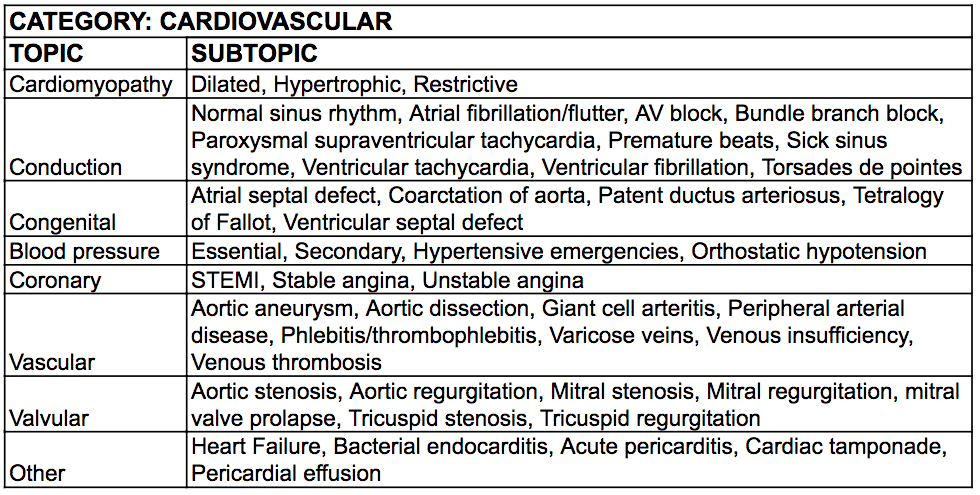The Exam Writer’s Strategy That Test Takers Don’t Know About (But Should)

Are you ready for a study strategy that will consolidate and organize your studying so you can more easily assess your progress, identify weaknesses, and get the confidence to enter your next exam ready to give the exam writers a real taste of who they’re messing with?
By the time you graduate from medical school, PA school, or NP school you will have taken an innumerable amount of exams, and yet, the fun doesn’t stop here. During residency you take Step 3 (CS and CK) and a board certification exam at the end or immediately after graduation. Depending on your specialty, you may have oral boards 1 or 2 years after that, followed by board recertification exams every 10 years (and we all thought the MCAT was enough). During PA school, you have didactic exams, rotation exams, summative exams, and your PANCE and PANRE. In NP school you have subject exams and certification exams. Yet despite the millions of questions in quizzes, tests, question banks, shelf exams, board, and board recertification exams, there are only so many ways that those exam-writing tricksters can test your understanding of the material. The breakdown that I’m sharing with you is the key to cutting down studying time and increasing test-taking success.
Before jumping into the exam, we must start by priming YOU. Start by imagining your brain as a filing cabinet. Each bit of new information must be incorporated and stored in a designated place. Otherwise, accessing information will be like searching for a needle in a haystack.
Your medical knowledge is divided into 16 CATEGORIES:

Within each CATEGORY there are TOPICS that are further broken down into SUBTOPICS.
Confused? Let’s use the category CARDIOVASCULAR as an example and break down the topics and subtopics:

THERE ARE ONLY 7 QUESTION TYPES. Yes, I repeat, there are 7 ways to test your knowledge, and once you know them, you will have gained a skill to master your studying and crush your medical examinations no matter what stage in the process you’re at.
The 7 question types:
- History taking & Physical exam
- Given XYZ presentation, what would you expect on the physical exam?
- XYZ was found on the physical exam, what history would have lead to this finding?
- Diagnostic studies
- After XYZ presentation, what is the best imaging modality to assess the patient?
- What lab should be ordered to confirm the diagnosis?
- Does XYZ require labs or is the diagnosis based on history and physical exam?
- Diagnosis
- Given XYZ presentation, which is the most likely diagnosis?
- What are the criteria to diagnose XYZ?
- Health maintenance
- What screening tests are recommended for this patient?
- What vaccinations are recommended for this patient?
- Is this patient part of an at-risk population?
- Clinical intervention
- Given XYZ presentation or diagnosis, what nonpharmaceutical actions can you take to control or manage the patient?
- Clinical therapeutics
- Given XYZ presentation or diagnosis, what medications can be used to control or manage the patient?
- What are the side effects of a given medication?
- What is the mechanism of action of a given medication?
- Scientific concepts
- What is the pathophysiology of XYZ?
As you see patients in clinic, or encounter them in question banks while preparing for your shelf or board examination, ask yourself if you have an understanding of the history taking & physical exam, diagnostic studies, diagnosis, health maintenance, clinical intervention, clinical therapeutics, and scientific concepts of a patient with a given presentation.
For some learners, having this framework in your mind is enough to guide your studying process, and you won’t need to physically keep track of every detail. For others, being able to see all the information in one place can be useful.
Using the model of category, subcategory, and topic, create a spreadsheet (Google Docs works great for this) with the 16 categories mentioned above with each in their own tab.

In the first vertical column, fill in the topics and subtopics as you encounter them in your studies, whether in a question bank or other resource. In the first horizontal row, place the 7 questions.
So the structure will look like this:

The next time you are going through a set of questions in the question bank, whether you get an answer correct or incorrect, check in with yourself before moving on if you would be able to answer the 7 questions. If so, move on, but if not, take the time to fill in the blanks either mentally or physically.
It really is that simple.
But wait! Before returning to studying, I want to remind you of the most critical piece of information. Never fail to recognize all of your accomplishments that enabled you to get where you are today. While many of us have gained studying skills to add to our toolbox by reading blogs on the internet or receiving advice from colleagues and mentors, ultimately, YOU know yourself and your brain functionality best. If you are an audio-visual learner, be proud and don’t get down on yourself if you can’t study from a textbook. If you prefer to soak up information like a sponge from reading, enjoy! No two students, residents, or practicing clinicians are alike, and as you take on studying for a new exam, whether it be a quiz, test, shelf, board exam, or certification exam, reflect back on what worked in the past and what didn’t and adjust accordingly. After all, insanity is doing the same thing over and over again and expecting different results.
Related articles
How to Choose Your Medical Specialty as a Fourth-Year Medical Student
How To Increase Your Family Medicine Certification Exam By 100 Points
Family Nurse Practitioner (FNP) – Board Certification Overview





Comments (0)